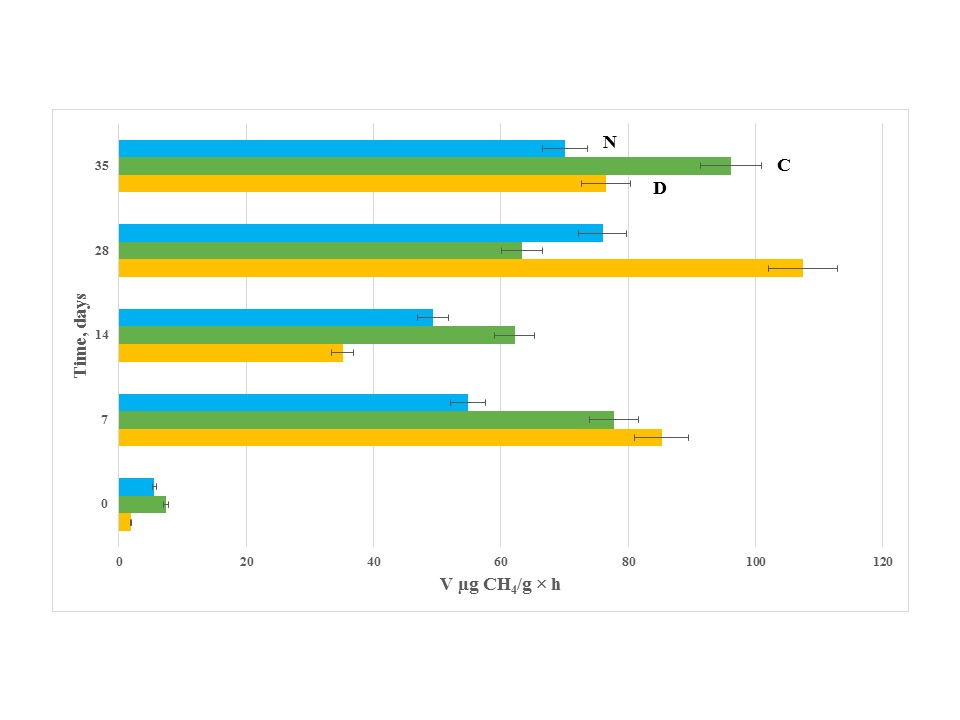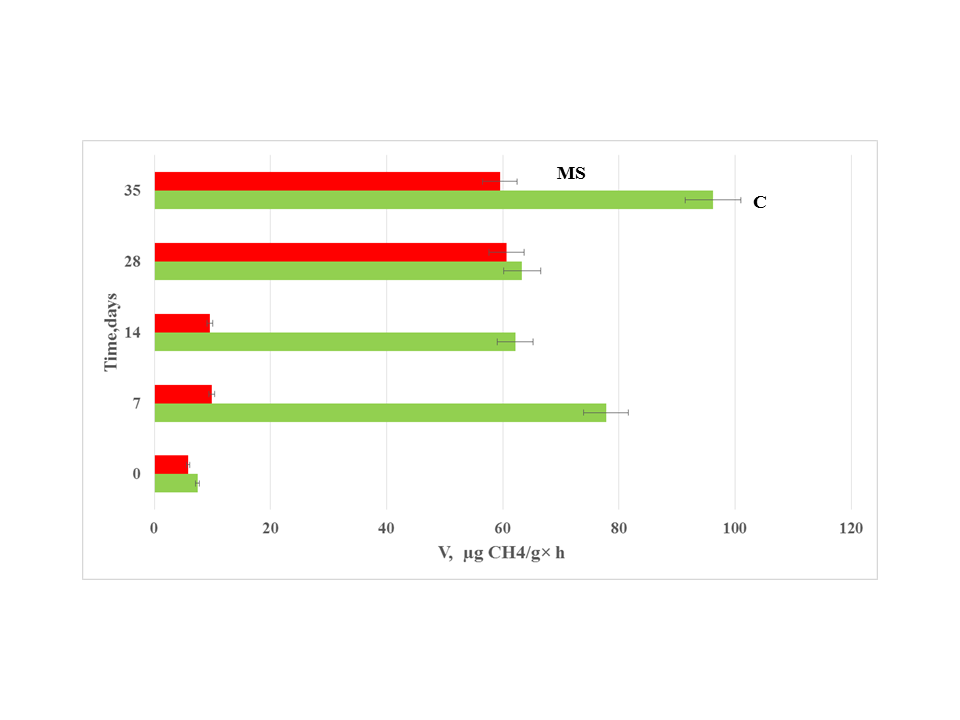MICROCOSM STUDY OF AMMONIUM AND DRYING IMPACT ON METHANE OXIDATION IN AGRICULTURAL SOIL
MICROCOSM STUDY OF AMMONIUM AND DRYING IMPACT ON METHANE OXIDATION IN AGRICULTURAL SOIL
Abstract
An important mechanism controlling the amount of methane in the atmosphere is aerobic methane oxidation, which is carried out by soil methanotrophs. Agricultural soils operate under stressful conditions brought on by anthropogenic activities and environmental change, and it is thought that ammonium and dryness have a significant impact on the activity of aerobic methane oxidation. However, there is dispute over how drying and ammonium affect soil methanotrophy, and there is still a dearth of information regarding the combined impact of these two factors. In the current work, agricultural soil microcosms were built to examine how methane oxidation responded to ammonium addition (100 g/g) and drying-rewetting stress over the course of a month-long incubation. As a benchmark, fresh soil was used. Throughout the whole incubation time, ammonium had a detrimental effect on the methane-oxidation activity, although this effect was restored.
1. Introduction
Modern agricultural production technologies are being developed and improved with the goal of using land resources wisely, which should result in a continuing trend of returning the land to its natural state of supporting plant growth and restoring the biosphere's functions. One of these systems' most important roles is to control how carbon dioxide and methane, the two main greenhouse gases, move between the soil and the atmosphere through the activities of the soil microbiota
.Despite having a far lower atmospheric concentration of methane than carbon dioxide, it has a 21-fold larger mass-per-mass infrared absorption capability
. The amount of methane in the atmosphere has significantly increased in recent years, and its increased concentration has resulted in radiation forcing that is one third that of carbon dioxide .Methane will continue to build up in the atmosphere if systems that release it from natural reservoirs are engaged as the temperature warms. At the same time, it is important to remember that aerobic soil methanotrophic bacteria are the only known mechanism for controlling the methane content of the atmosphere for terrestrial ecosystems
.The amount of greenhouse gas emissions into the atmosphere is rising as a result of increasing anthropogenic environmental impact, and agricultural soils typically see a shift in the balance in favor of methane emissions
. Due to the increasing amount of ammonium, a concurrent inhibitor of methane oxidation, mineral nitrogen fertilizers can lower the activity of methane oxidation in soils . The uptake of methane was shown to decrease as the soil dried out and increase once more after moistening . Molecular techniques are currently being used to investigate how stress affects the variety of soil methanotrophs . To assess how methanotrophic communities respond to stress, essential markers like the rate of methane oxidation still matter.The mechanisms governing methane uptake in aerobic soils have not yet been properly investigated, despite the fact that there has been a lot of effort on this topic. Methane in agricultural soils has received particular interest, since methane uptake there can be controlled by using contemporary agricultural management techniques. This establishes the current study's significance.
The purpose of this research is to characterize, under carefully controlled laboratory circumstances, how ammonium and drying treatment affect the activity of methanotrophs in soddy-podzolic soil. We aim to specifically respond to the following queries. (i) In postagrogenic soil with a high amount of organic matter, does ammonium hinder methane oxidation? (ii) How does drying affect the uptake of methane? (iii) Do ammonium and drying stress interact in a beneficial way?
2. Research methods and principles
On June 5, 2022, soil was collected in the Odintzovo area of the Moscow Region, Russian Federation, near the Petelino poultry production facilities from postagrogenic herb-bunchgrass meadows (50°36'33" N, 36°49'39" E). According to estimates, the soil is soddy-podzolic and heavy loamy on layers of a moraine (Retisols according to FAO classification; Eutric Albic Retisol (Abrupt, Loamic) according to the WRB). Table 1 lists general soil properties.
Table 1 - General parameters of the experimental soil
Soil’s parameter, dimension | Parameter`s value |
Texture, fraction content % 0.5-0.25 mm 0.25-0.05 mm 0.05-0.01 mm <0.01 mm |
45.76 23.30 25.79 5.15 |
Water content, % | 3.01 |
Losses during calcination | 15.29 |
pHH2O | 7.6±0.1 |
Total nitrogen,% | 0.37± 0.02 |
Total carbon, % | 4.15 ±0.36 |
C:N | 11.21 |
Soil density, g/cm3 | 2.55 |
Corg, % | 5.97±0.9 |
Na+, mmol/100g | 0.283±0.01 |
К+, mmol/100g | 0.550±0.01 |
Ca2+, mmol/100g | 18.15±0.21 |
Mg2+, mmol/100g | 5.852±0.073 |
Basal microbial respiration, µg С-СО2/g × h | 0.82 ±0.02 |
Microbial biomass, µg С/g | 1252±65 |
Metabolic coefficient (QCO2) | 1.35±0.03 |
In September 2022, 100-ml flasks containing 10 g of fresh soil subsamples were used to create microcosms. Incubation experiments in the following series were planned: K: control; distilled water was supplied; N: application of ammonium chloride water solution (100 g NH4+N/g); D: drying and rewetting of the soil; ND: drying of the soil and addition of ammonium solution. Methane oxidation activity was measured once a week while microcosms were cultured in desiccators for a month with a methane-air mixture (20:80) at 25 oC, as stated in our prior article
.As the means of five samples, the data are displayed. In every study, a p-value of 0.05 was used to determine if the reported treatment effects were statistically significant. Excel (Microsoft Office Excel) was used to conduct the statistical analysis.
3. Main results
Total nitrogen (0.37%) and organic carbon (5.7%) are both present in high concentrations in the examined soil (table 1). This is because over a lengthy period of time, while the soil was being used for agricultural production, a sizable amount of organic waste (chicken dung) was added to it. The soil is extremely active, according to indicators of integral microbiological activity (basal respiration, microbial biomass, and QCO2) (table 1).
When the impact of ammonium on the methane oxidation activity of soddy-podzolic soil was assessed (figure 1), it was discovered that the rate of methane oxidation significantly decreased after ammonium addition, and this pattern persisted throughout the entire observation period by the experiment's 35-day conclusion. This agrees with the findings of further investigations ,
.
Figure 1 - Dynamics of the soil methane oxidizing activity in microcosm experiments
Note: abbreviations: C, control, without substrate addition; N, ammonium addition; D, drying-rewetting
The results of the investigation on multiple (stress-on-stress) effects (figure 2) showed that the activity of methane oxidation in soddy-podzolic soil was significantly reduced by the simultaneous application of ammonium salts and drying. The multi-stress inhibitory effect was evident during the entire observation time, in contrast to the effects of individual stressors. Furthermore, it has far more effects than the sum of their parts, which can be characterized as synergy.

Figure 2 - Dynamics of the soil methane oxidizing activity in microcosm experiments with soil under stress-on-stress impact. Abbreviations: C, control, MS, multi stress (simultaneous drying-rewetting and ammonium addition application)
4. Discussion
The costs to organisms of physiological reactions to stress can change the fluxes of carbon, energy, and nutrients within an ecosystem. These significant effects are obtained directly by altering the physiology of active bacteria and managing the microbial community . Many acclimation and adaption strategies enable microorganisms to withstand environmental stress. Since microorganisms have a finite lifespan and are susceptible to stress, a changing environment may result in situations that are stressful for them. Research has only partially delved into the intricate network of influences that ranges from environmental factors to microbial physiological responses, changes in community structure, and ultimately ecosystem scale dynamics
, .Due to the competitive inhibition of methane oxidation enzymes, ammonium has been proven in numerous investigations to be a potent inhibitor of methane oxidation in soil. Furthermore, methanotrophs may become hazardous from accumulating ammonium oxidation products, such as nitrite and hydroxylamine
. The impact of ammonium on the oxidation of methane is still debatable. There is evidence in the literature that adding ammonium can both have no apparent impact and promote soil methanotrophic activity .Drought is likely the environmental stress that soil microorganisms experience most frequently. Drying soils limit substrate diffusion, which can leave bacteria short on resources. Drying-rewetting occurrences occur, primarily in the summer, in soil ecosystems that have been impacted by anthropogenic activity and are being plowed. Soil quality is altered as a result of the destruction of the soil's structure, including its aggregate and pore size, organic matter content
, and nutrient concentrations, particularly those of carbon, nitrogen, and phosphorus . Soil bacteria may be able to regulate processes that are controlled by drying and rewetting. The effects of drying and rewetting soil on microbial communities have been the subject of numerous research. In the majority of these tests, the broad microbiological parameters—such as respiration, enzyme activity, biomass carbon content, etc.—were examined (see, for instance, 20–22). Studies that examined the effects of soil drying and rewetting on microbial communities with specific biogeochemical properties, such as soil methanotrophs, are few and far between .A growing body of research indicates that many types of stressors may have an additive effect that is greater than the sum of their individual effects . The identification of such impacts is crucial for a comprehensive assessment of environmental risk, since stressors that by themselves may not have quantifiable effects on survival may in fact amplify the effects of other stressors. It is evident from examples of experimental investigations that are now accessible in the literature that increased environmental stress significantly affects a person's sensitivity to toxicants
, .5. Conclusion
Despite the fact that soils are under growing environmental pressure and that soil microorganisms are in charge of important ecological processes, little is known about how resilient soils are to various stresses. In this experiment, the soil methane oxidizing communities are repeatedly perturbed by soil dryness, ammonium addition, and their combination. We studied the oxidation of methane both before and after disturbances in soil microcosms. It might be challenging to ascertain how a change in a broad function, like respiration, in response to stress or disturbance, because diverse species in soil microbial communities carry out the same activity. Assessing a specific soil function has been suggested as a way to help determine how stress affects a soil ecosystem.
The soil used in this investigation was brought into the lab and subjected to two different stressors. This design has the advantage of reducing the noise seen in natural systems, which enables us to more precisely quantify the effect. This method, meanwhile, falls short of fully capturing the complexity of natural systems.
Furthermore, compared to the method used here, soils in natural systems are vulnerable to more intricate combinations of stresses. Even while laboratory testing is crucial, more investigation into actual soils is required to validate these findings in a broader ecological context.
